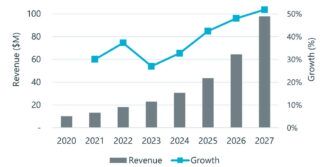The latest iteration of WAE EV platforms, EVR is focused on the growing electric hypercar sector, with a lightweight composite structure that mounts the high-performance battery system in the middle of the vehicle, optimising centre of gravity.
EVR can support a range of electric hypercar configurations, from track-only vehicles where power-to-weight is maximised to roadgoing models, both open-roof Targa and fixed-roof GT architectures. This is made possible by the architecture’s central tub which has been designed from day one to allow for such flexibility, including open roof design, whilst still featuring the very latest performance technology such as active aerodynamics.
With a state-of-art 85kWh battery and peak power of 1650kW, EVR enables sub-2.0secs 0-100km/h acceleration and a top speed more than 400kmh (248mph) with a vehicle mass less than 1800kg, along with fast-charging capability of sub-20mins and a range in excess of 450km (279 miles). All-wheel drive and rear-wheel drive layouts are supported through multiple e-motor configurations.
EVR’s inherent flexibility and modularity means WAE’s offering to customers is unique. For start-ups, EVR provides a complete turnkey solution, with WAE delivering the entire vehicle, with exterior design support supplied by the customer or a WAE partner.
For OEMs, EVR accelerates route to market, with the entire engineering and assembly of the rolling chassis completed by WAE. Capable of being adapted for both the OEM’s design and styling requirements, EVR reduces time from development to market launch.
Equally, for OEMs and Tier 1s, EVR provides the opportunity to integrate new products to push the boundaries of electric powertrain technology, with the rolling chassis capable of being continuously developed with WAE’s newest motor and battery technologies.
Engineered for maximum flexibility for customer requirements, both in terms of interior and exterior design, EVR results in a reduced time to market with class-leading performance, with WAE targeting delivery of a first EVR-based prototype within 12 months from project kick-off to delivery of a first production vehicle in 24 months.
EVR is also ready for a hydrogen future with an EVR-H fuel cell variant also being developed to deliver the equivalent performance of a pure BEV platform but powered by green H2.
Paul McNamara, Williams Advanced Engineering Technical Director, said: “EVR combines WAE’s exceptional expertise in motorsport-bred lightweight, composite structures and high-performance battery powertrains with our knowledge in developing and delivering electric vehicle programmes. It rapidly accelerates high performance electrification offering a turnkey solution for both start-ups and OEMs with an affordable business case, reduced time to market and a highly flexible architecture.”

Photo: Williams Advanced Engineering


![Forecasts, Opportunities, and Challenges for the Polish Industry in 2024 [ANALYSIS] Forecasts, Opportunities, and Challenges for the Polish Industry in 2024 [ANALYSIS]](https://industryinsider.eu/wp-content/uploads/xIndustry-40-320x167.jpg.pagespeed.ic.o8zijDQlIJ.jpg)
![The importance of artificial intelligence in transport and automotive industry is growing [REPORT] The importance of artificial intelligence in transport and automotive industry is growing [REPORT]](https://industryinsider.eu/wp-content/uploads/xcity-320x167.jpeg.pagespeed.ic.xFkQdk7qXO.jpg)
![By 2030, the market size of metal processing tools is expected to reach $120.44 billion [REPORT] By 2030, the market size of metal processing tools is expected to reach $120.44 billion [REPORT]](https://industryinsider.eu/wp-content/uploads/xcutting-tools-320x167.jpg.pagespeed.ic.SgnEk-RWA-.jpg)
![Methane emissions remains elusive challenge for oil and gas industry [REPORT] Methane emissions remains elusive challenge for oil and gas industry [REPORT]](https://industryinsider.eu/wp-content/uploads/xMethane-emissions-by-source-320x167.jpg.pagespeed.ic.q-7jG2luXb.jpg)

![Will digital twin revolutionize the aerospace and defense sector? [REPORT] Will digital twin revolutionize the aerospace and defense sector? [REPORT]](https://industryinsider.eu/wp-content/uploads/xdigital-twin-in-aerospace-320x167.jpg.pagespeed.ic.K-YNPhggcS.jpg)